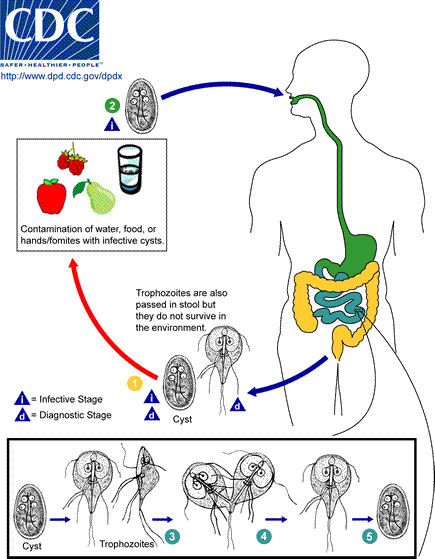| |
Cysts are resistant
forms and are responsible for transmission of giardiasis. Both cysts and
trophozoites can be found in the feces (diagnostic stages)
 .
The cysts are hardy, can survive several months in cold water. Infection
occurs by the ingestion of cysts in contaminated water, food, or by the
fecal-oral route (hands or fomites) .
The cysts are hardy, can survive several months in cold water. Infection
occurs by the ingestion of cysts in contaminated water, food, or by the
fecal-oral route (hands or fomites)
 . In the
small intestine, excystation releases trophozoites (each cyst produces two
trophozoites) . In the
small intestine, excystation releases trophozoites (each cyst produces two
trophozoites)
 .
Trophozoites multiply by longitudinal binary fission remaining in the lumen
of the proximal small bowel where they can be free or attached to the mucosa
by a ventral sucking disk .
Trophozoites multiply by longitudinal binary fission remaining in the lumen
of the proximal small bowel where they can be free or attached to the mucosa
by a ventral sucking disk
 .
Encystation occurs as the parasites transit toward the colon. The cyst is
the stage found most commonly in non-diarrheal feces .
Encystation occurs as the parasites transit toward the colon. The cyst is
the stage found most commonly in non-diarrheal feces
 .
Because the cysts are infectious when passed in the stool or shortly
afterward, person-to-person transmission is possible. While animals are
infected with Giardia, their importance as a reservoir is unclear. .
Because the cysts are infectious when passed in the stool or shortly
afterward, person-to-person transmission is possible. While animals are
infected with Giardia, their importance as a reservoir is unclear. |
|
